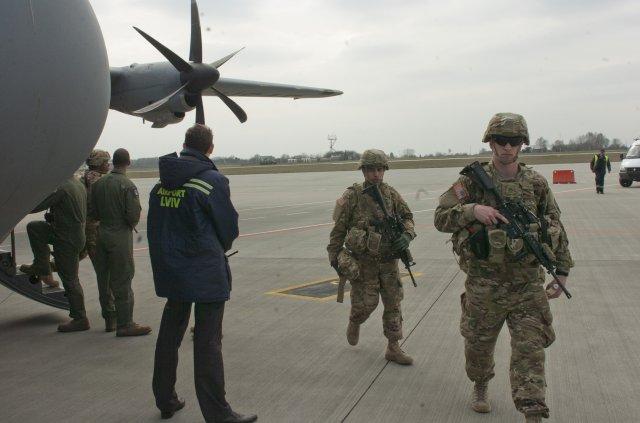Russian Drone Threat: Army Seeks Ukraine Lessons
Posted on

US 173rd Airborne soldiers arrive in Lviv to train the Ukrainian National Guard.
AUSA: Watch the skies: The US Army is paying close attention to Russia’s “massive use of drones [to spot for] artillery,” Gen. David Perkins, head of the powerful Training & Doctrine Command, said here today.
“In Iraq and Afghanistan, we were kind of the only ones that had Unmanned Aerial Systems [UAS or UAVs] and they pretty much flew in uncontested airspace,” Perkins said. “Now, what we’re seeing in the Ukraine, is the enemy has unmanned aerial systems, they’re deploying them pretty effectively, and the airspace we’re used to operating them in is becoming very contested.”
Nor do the Russians use their drones the way Americans do, for prolonged surveillance and the occasional precision strike. Instead, the Ukrainians have learned, the hard way, that when they see certain kinds of Russian UAV overhead, an all-out barrage will follow.
The Ukrainians report that “when they see certain type UAVs, they know in the next 10-15 minutes, there’re going to be rockets landing on top of them,” Hodges said. This isn’t precision fire, but heavy bombardment. “It shreds light-skinned armored vehicles,” Hodges said, citing studies by Potomac Foundation president Phillip Karber, who’s extensively visited the Ukrainian battlefront.
Russian cannon and rocket artillery causes 85 percent of Ukrainian casualties, Karber told the AUSA conference, his slides showing columns of burnt-out transports and rows of body bags. The Russians use scatterable submunitions that Western nations have renounced for doing too much collateral damage, he said. They employ thermobaric weapons that create enormous fires. They have precision weapons that target the thinly armored tops of armored vehicles.
“In a three minute period… a Russian fire strike wiped out two mechanized battalions with a combination of top-attack munitions and thermobaric warheads,” Karber said. Western militaries need to start planning for massive casualties again, he warned. “You lose commanders, you lose your medical staff, people are screaming around on fire. There is no airlift to move out one or two casualties, you’re dealing with hundreds.”
Lightly armored transports — like the US Army’s Stryker — are “very vulnerable on this battlefield,” Karber warned. Such vehicles shrug off small arms fire and fair fairly well against the underbody blasts of roadside bombs. But an artillery shell from above or a 30mm cannon burst from the side can kill the vehicle and all 11 men inside.
The Army is urgently upgunning the Stryker — but not uparmoring it — to face the Russian threat. US Army Europe has requested a 30 mm cannon for the Stryker, which would allow it to destroy comparable Russian vehicles like the BMP at long range. But what about defense?
“Not all answers need to be more armor,” said Col. Glenn Dean, the Army’s project manager for the Stryker vehicle. Stryker units will have to operate differently in the face of different threats. “Not all challenges are answerable by materiel solutions.”
It’s important to note that Stryker brigades are a mid-weight unit, heavier than foot infantry but lighter than main battle tanks. They’re tactically not intended to face Russian heavy armor or artillery head-on. That’s the mission of armored brigade combat teams (ABCTs), the last of which was withdrawn from Europe years ago.
Two years after the last tank left Europe, head of US Army Europe Lt. Gen. Ben Hodges noted, the Army is putting an armored brigade’s worth of equipment back into Europe. That’s some 1,200 vehicles — including 245 M1 tanks, M2 Bradley troop carriers, and M109 howitzers — that will be stored in “Estonia, Latvia, Lithuania, Poland, Romania, Bulgaria, and Germany, and eventually Hungary,” Hodges said. Troops will come from the US in shifts to train on them.
“Just about every logistics leader in the Army above the rank of corporal has been over to Europe to put their eyes on it and put personal energy into getting the maintenance done, getting the equipment over, getting tan-painted vehicles [from Iraq] painted green,” Hodges said.
Subscribe to our newsletter
Promotions, new products and sales. Directly to your inbox.
